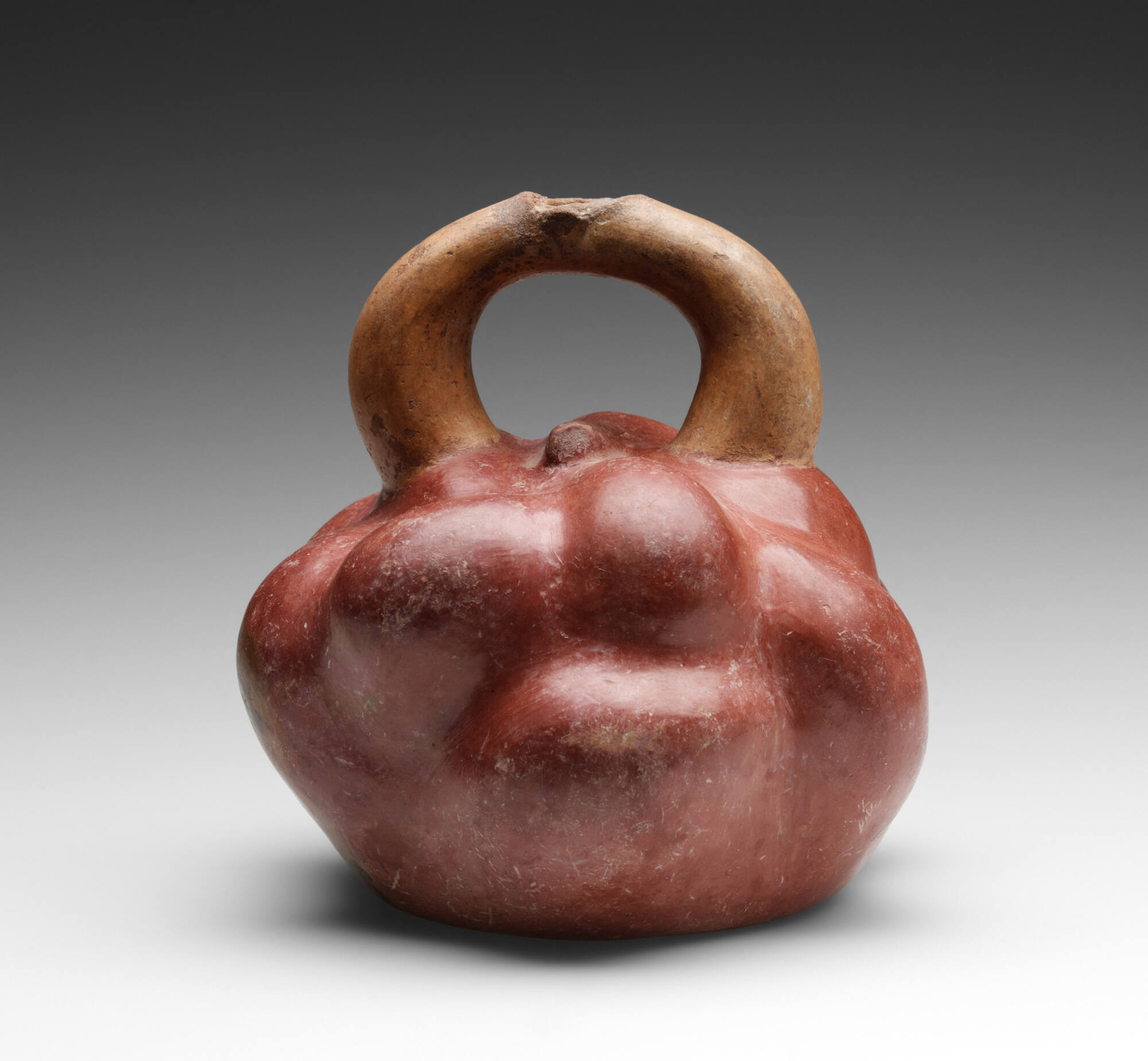
Object Details
Culture
Moche (Peru)
Early Intermediate Period
Date
100-600 AD
Medium
Redware
Dimensions
Height: 6 3/16 inches (15.7 cm)
Credit Line
Transfer from the Sociology – Anthropology Department. Spring 1956.
Object
Number
56.184
BRIEF DESCRIPTION
The term “effigy” is used to describe a sculpture or vessel in the shape of(…)
BRIEF DESCRIPTION
The term “effigy” is used to describe a sculpture or vessel in the shape of a person, animal, or even, in the case of this Moche pot, a fruit or vegetable.
WHERE WAS IT MADE?
This vessel was made in what is now Peru.
HOW WAS IT MADE?
The Moche made many of their ceramics using two-part press molds, a technique that enabled potters to make multiple pots of uniform design. First an original form was made from clay. In some cases, actual fruits and vegetables appear to have been used as the original forms for molds. After creating the mold (also ceramic) from this original, clay would be pressed into each half, and then later joined together. Sometimes hand modeling or coiling would also be utilized, and more than one technique could be used to produce a single pot.
The vessel was painted with a red slip and then burnished before it was fired. Slip is a mixture of clay and water. The red color in the slip comes from iron naturally present in the clay. When the vessel was fired in a shallow earthen pit, the presence of heat and oxygen oxidized the iron in the clay, enhancing the red color of the slip.
HOW WAS IT USED?
The function of pre-Columbian ceramic vessels is not easy to ascertain. Were these vessels made for the dead, fancy grave goods with specific religious or mythical imagery, or were they treasured possessions used in life? Or both?
Although most pottery made in the past was functional ware used to cook, store, or serve foods, more elaborate pieces also conveyed social information. It appears that pre-Columbian people may have had special pots for display in their homes or for use during special occasions. According to the earliest chroniclers after the Spanish conquest, people put pottery on display in their homes that reflected what they did to make a living; for example, fishermen displayed pots with sharks in their homes, while hunters displayed pots with deer and other land animals. Perhaps the many pots made in the shape of common fruits and vegetables, such as squash and corn, were displayed in the homes of farmers.
Bottles of this stirrup-spout type may have been used to carry and serve liquids, since the narrow-necked bottle shape would have reduced losses from accidental spills and evaporation. Although water is vital in desert environments such as those found in many parts of the Andes, recent analyses of residues from Peruvian bottles and jars suggest that most of them were used to serve corn (maize) beer or chicha. Chicha was both an everyday beverage, made in households for family consumption, and an essential element in ritual and social interactions.
WHY DOES IT LOOK LIKE THIS?
This burnished Moche redware vessel in the shape of a fruit or vegetable has a lumpy, irregular surface. The vessel body is painted in red slip, while the stirrup-spout handle is painted in tan; these colors are characteristic of Moche ceramics. The upper spout is broken off at the junction with the stirrup. A wide variety of plants and animals are found in Moche works of art. To see other pre-Columbian vegetable shaped vessels in the Johnson Museum’s collection, search for object numbers 56.159, 2003.043.005, 2006.070.044, and 2006.070.143 in the keyword search box.
ABOUT THE MOCHE CULTURE:
Arguably one of the finest technological manifestations of the pre-Columbian potter’s art, Moche ceramics have charmed generations of archaeologists and collectors with their finely executed painting and exquisite sculptural forms. Moche (formerly known as Mochica) pottery is characterized by red painting on a white or cream-colored slip ground. Moche stirrup-spout bottles represent a wide variety of sculptural forms, including human portraits, animal effigies, domestic scenes, or graphic human sexuality. The core area of Moche cultural influence extended from Lambayeque in the north to Nepeña in the south, and likely reflects militaristic conquest and political control by a state-level polity centered in the Moche Valley. The Moche united many coastal groups, built and controlled extensive irrigation networks, and produced ceramic vessels using molds, a technological innovation which enabled the production of vast numbers of highly detailed ceramics, including portrait head vessels so finely detailed that individual faces can be recognized. Fineline paintings depict detailed, elaborate scenes now thought to be part of the “warrior sacrifice” or “presentation theme” story central to the Moche religion. Moche metalwork also achieved remarkable levels of sophistication, with precious stones inlaid in ornaments made of copper, silver, and gold alloys.












